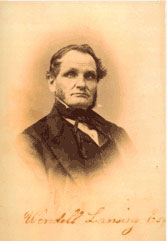Before reaching the Peru farms of Samuel and Catharine Keese and the farm of their nephew, Stephen Keese Smith, some fugitives were assisted in Keeseville by the abolitionist publisher of the Essex County Republican, Wendell Lansing.

Wendell Lansing
Midway between Keeseville and Peru is the Keese Homestead at the corner of Harkness Road and Union Road. Fugitive slaves may have been hidden there, but, in Smith's Recollections, there is no mention of his cousin Peter, who built the stone mansion. Peter Keese, however, was an abolitionist. In 1837, he signed a petition calling for the creation of the Clinton County Anti-Slavery Society.
A family story corroborates Smith's recollections about his own activities. His great-granddaughter, Virginia Mason Burdick, said her grandfather told her he remembered that when he was a boy, runaway slaves would come into the kitchen "chattering with the cold" and that "the firelight would light up their dark startled terrified faces."
Ironically, the Smith farm was not always owned by abolitionists: it was homesteaded by a slave owner, John Haff. Smith told the following story of a young, enslaved man who tried to run away from Haff to Vermont, which had been a free state since 1777:
A twenty-year old Negro boy belonging to John Haff ran away to Essex. They wouldn't ferry him across the lake to Charlotte, Vermont because they knew he was a runaway, but detained him till Haff came. Haff came on horseback, put a rope around the boy and fastened the other end of the rope to the saddle and started for home, making the boy walk. Whenever the boy lagged Haff would whip him. At Keeses the boy fell, faint and limp as a rag. He had been whipped a great deal and was exhausted. After resting awhile they started again and came up to the centre of the Union to Uncle Henry Green's. They stayed there all night, as it was so dark they could not well go through the blazed road. Mr. Haff put the Negro under the horses manger. He tied the rope so tight around the Negro's wrist that the boy moaned and cried so piteously the old man could not sleep. He went out and loosed the rope, which had cut through into the skin. At daylight they went through to Mr. Haff's place one and one half miles. Part of the land this slave worked on I now own.
John Haff deeded a portion of his property to his son, Abram, who became an abolitionist Methodist minister and a member of the Executive Committee of the Clinton Country Anti-Slavery Society. Rev. Haff sold the farm to Stephen Keese Smith in 1852.
The Haff-Smith farm represents several important stages of Clinton County's slavery and abolitionist history. In turn, it was the property of a slave owner, an abolitionist, and an UGRR agent.
Quaker Samuel Keese was the head of Peru, New York's UGRR depot. Now the memoir Samuel wrote as a tribute to his wife after her death is available online. Simply search https://books.google.com/books and type in Memoir of Catherine R. Keese.
For more information on this and other stories of the UGRR in Clinton County, contact Don Papson at don.ugr@frontier.com
Sources:
Addie L. Shields, The John Townsend Addoms Homestead: Including a study of slavery and the Underground-Railroad As It Pertains to Clinton County, NY (Plattsburgh, 1981). Item 19.
Dr. David Sherwood Kellogg Collection, 70.8, Box 5, Folder 1: Recollections Told by Various Persons, June, 3, 1887: Stephen Keese Smith (Battle of Plattsburgh and the Underground Railroad). Special Collections, Benjamin F. Feinberg Library, State University of New York at Plattsburgh.
Hiding place photo by Don Papson.
Samuel Keese, A Memoir of Catharine R. Keese Late of Peru, NY. Comprising Extracts from Her Letters and other Sketches; with Selections From Those Addressed to Her, and the Testimony, of Others Concerning Her, by Her Husband and Friends (New York: James Egbert, Printer, 1866), 73.
Stephen Keese Smith Home, barn, and entrance to hiding place photos by Laura Sells Doyle.
Stephen Keese Smith, Samuel Keese, Catharine R. Keese, and Noadiah Moore images, courtesy Special Collections, Benjamin F. Feinberg Library, State University of New York at Plattsburgh.






